BougeRV Yuma 200W CIGS solar panel review: lightweight, rollable, durable
The BougeRV Yuma 200W CIGS solar panel name might be a mouthful, but it is quite a versatile solar panel that can be used across a variety of use cases.
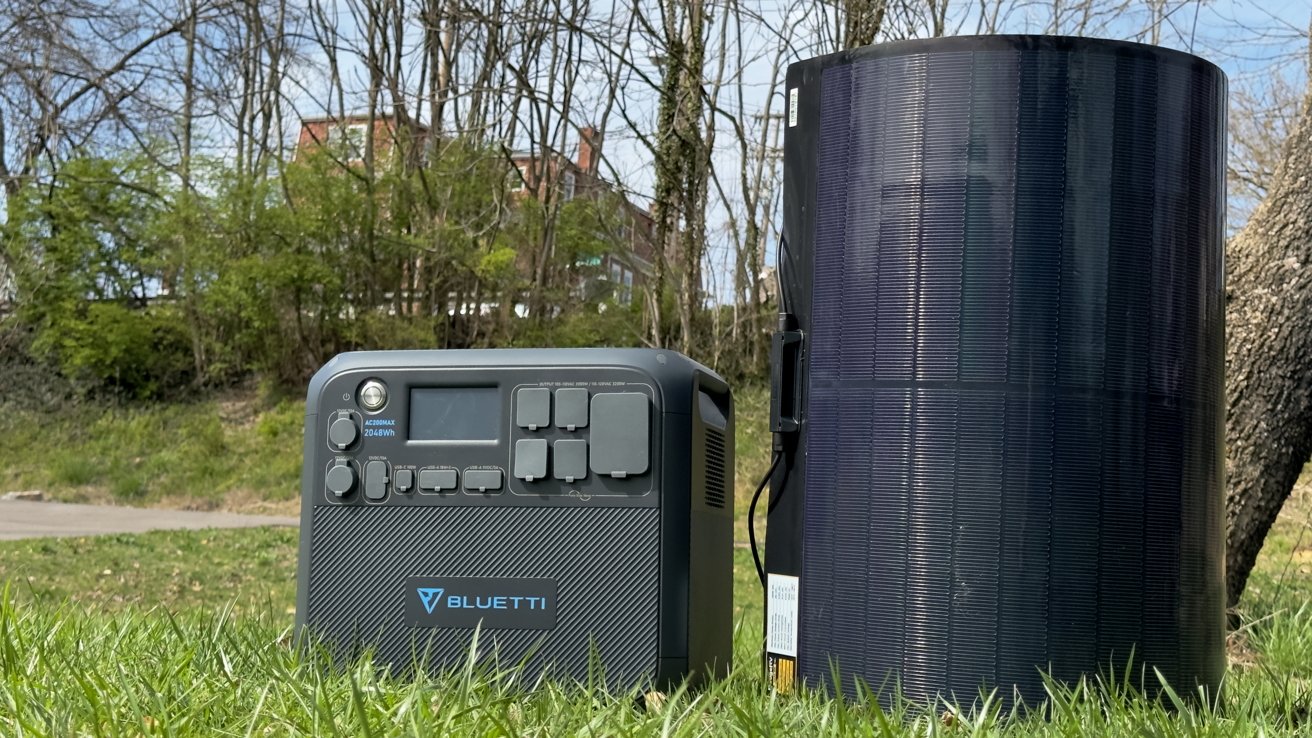
A flexible, rollable solar panel
We're used to seeing solar panels come in rigid square mounts that are big and heavy. Instead, they tend to fold into small suitcase-sized carrying cases or are much larger and intended for permanent mounting.
BougeRV has something a little different for the solar panel market -- a flexible, rollable panel that's super thin and can be mounted with adhesive. The Yuma 200W CIGS thin-film Flexible Solar Panel is unique in its ability to adapt to various surfaces for permanent or portable use.
This product fits a very specific market, so we won't say this is a go-to option for everyone. In addition, it won't replace the utility of a more traditional briefcase-style solar panel in some instances, like when portability and minimal storage are a priority.
The Yuma 200W CIGS solar panel is made up of copper indium gallium selenide (CIGS) solar cells, which are more flexible. They can maintain a stable output even in the shade or if sections of the panel are damaged.
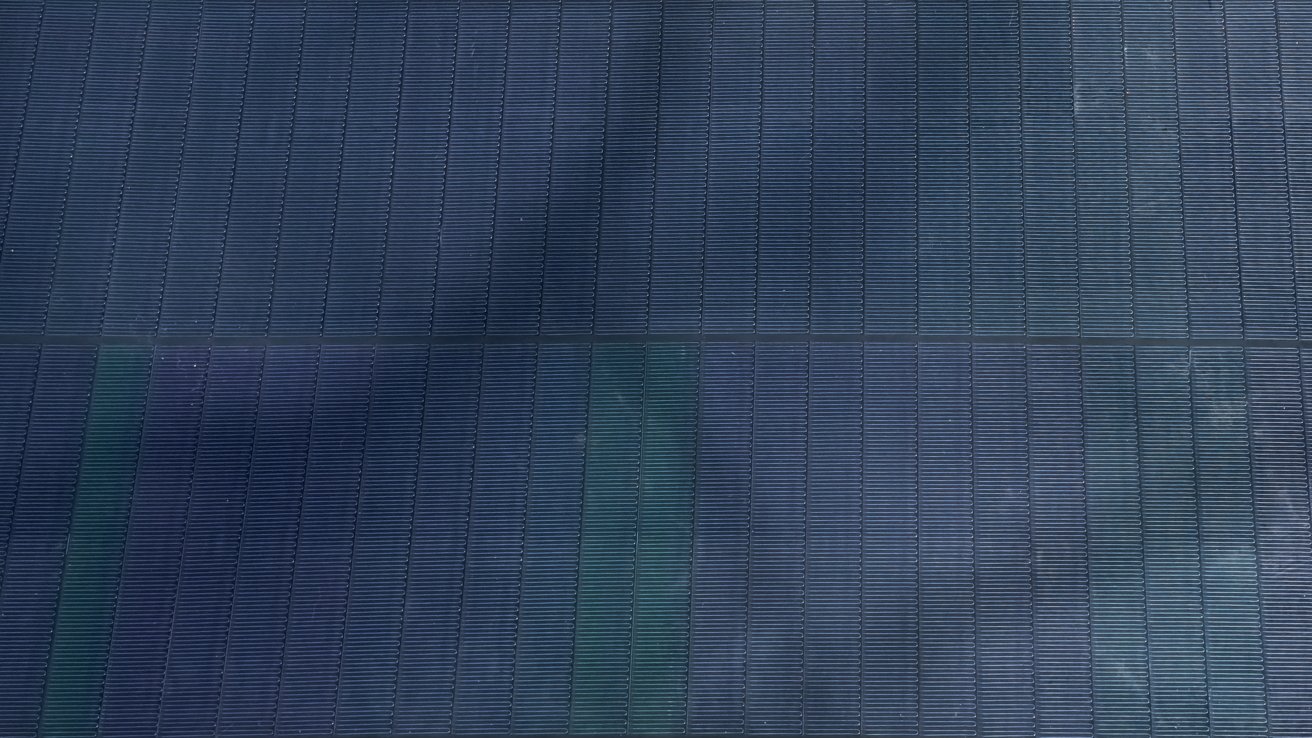
The CIGS solar cells allow the panel to fit curved surfaces
There is no glass in the construction, which makes the entire enclosure more durable and less prone to damage. The solar panel is also waterproof to the IP68 standard -- so it'll survive the rain.
When rolled up, the Yuma solar panel has an 11-inch diameter and is 26 inches tall. It rolls out to 85.6 inches and can only be rolled in one direction, or else the cells will be damaged. It weighs only 7.05 pounds.
The panel is only 1mm thick, and the rear is covered in double-sided adhesive. We've not removed the adhesive covers, as this would be used for more permanent mounting, like on a camper.
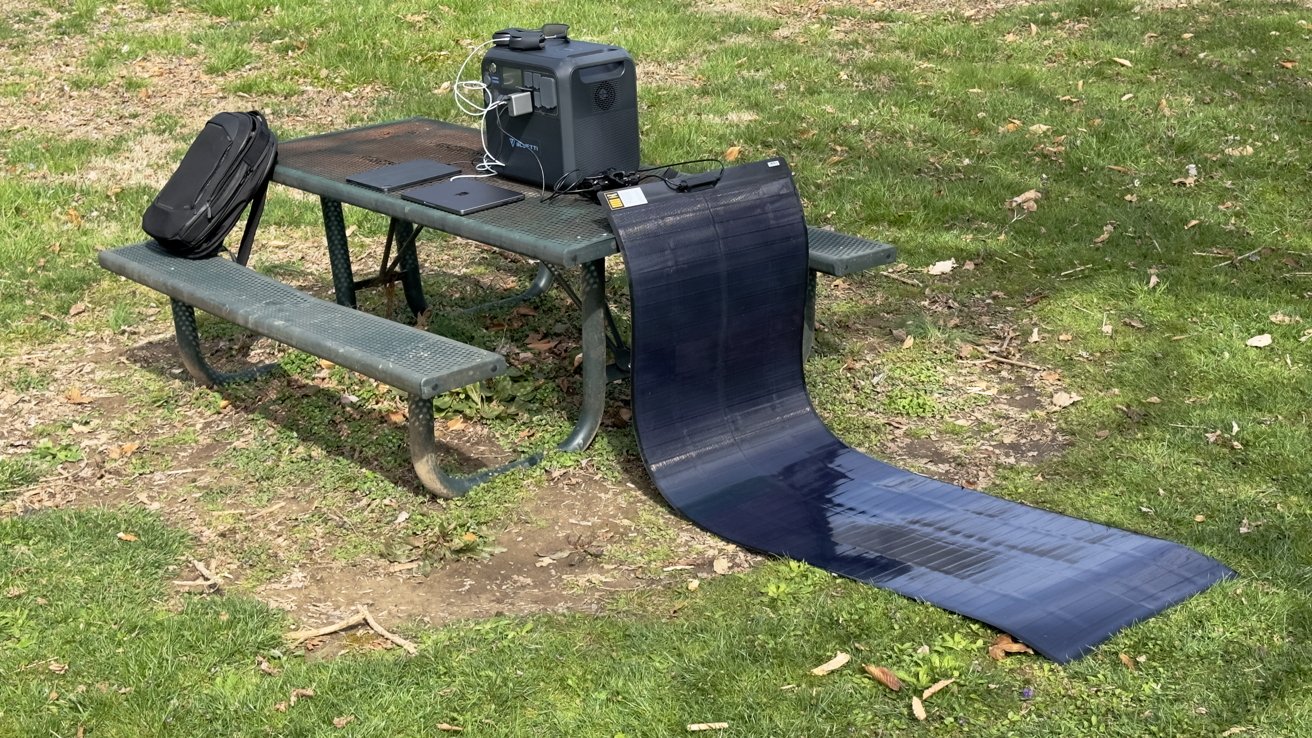
The Yuma 200W CIGS solar panel is rather large when rolled out
The Yuma 200W CIGS solar panel is what the name implies -- it produces 200W of output in ideal conditions. The MC4 connectors are compatible with any power station using that connector.
The panel can be connected in series or parallel with other solar panels to achieve the desired voltage or current. The maximum system voltage is 1000V DC.
We've seen the briefcase-style solar panel with rigid glass construction achieve about 24% solar cell efficiency. The Yuma solar panel has a 16% efficiency, which is likely a tradeoff for its construction.
We have the model with adhesive, but there is also a model with pre-drilled holes for more permanent mounting.
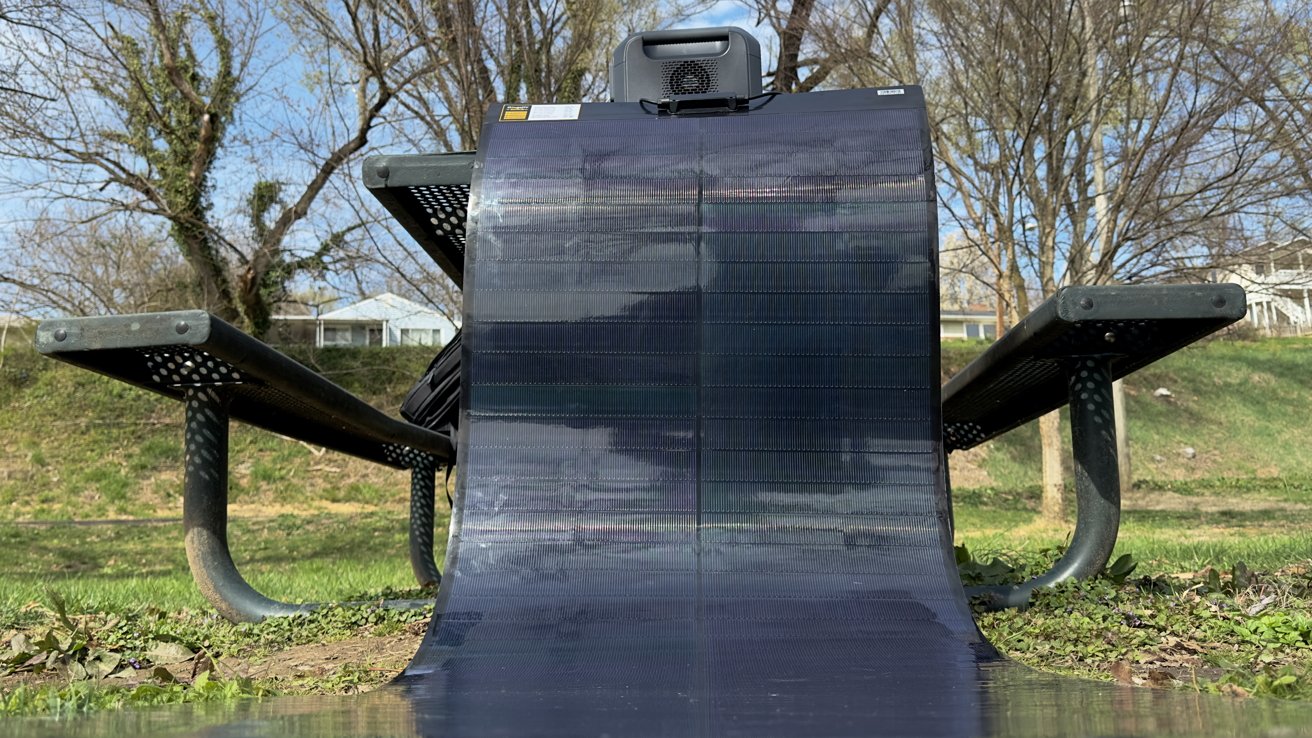
The late afternoon sun and cloud cover didn't do us any favors in testing
Out in the park on a partly cloudy day, the panel produced about 50W. This was also likely due to the power station not being too low, at about 80% charge.
In direct sunlight, with the panels angled perpendicular to the sun, we've managed to get up to 150W. This is normal for solar panels, as they require some level of precision to get the maximum rating.
Anything above 100W is excellent for keeping the battery at a minimal discharge with our devices connected. Of course, it isn't going to charge a battery this size very quickly, but it is better than nothing -- especially if the power is out.
The Yuma 200W CIGS solar panel isn't exactly portable, even when rolled up. It's just big enough to be awkward, but it'll do in a pinch if this is your only solar panel.
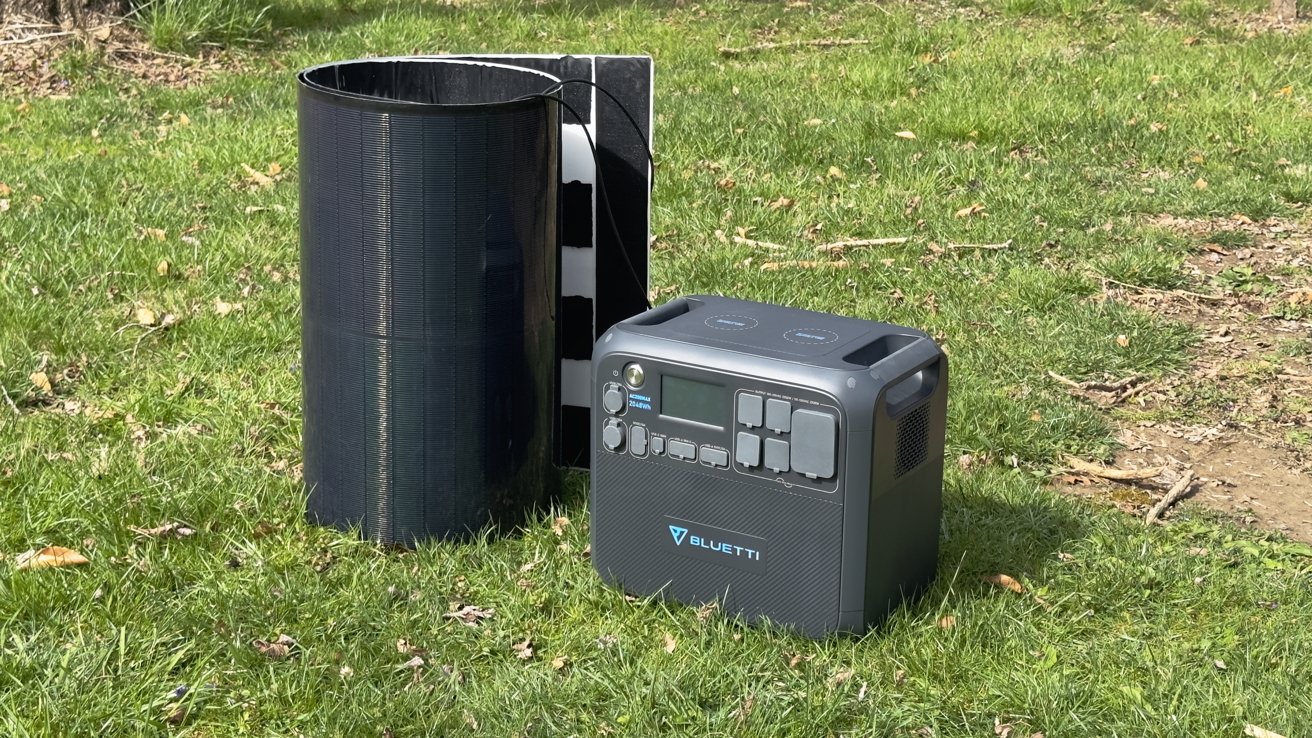
The Yuma 200W CIGS solar panel isn't for everyone, but it gets the job done
When solar power isn't required, it can be taken down, rolled up, and stored without taking up much space. However, it is a large-ish object even when rolled.
We expect it will provide the most use as a permanent or semi-permanent installation. However, there are better portable options with this output and price.
However, as mentioned throughout this review, this is a very niche product. Unless you're looking for a solar panel with these specific specs and design, there are likely better options.
Customers can also purchase the solar panel directly from BougeRV for $579.99.
Read on AppleInsider

A flexible, rollable solar panel
We're used to seeing solar panels come in rigid square mounts that are big and heavy. Instead, they tend to fold into small suitcase-sized carrying cases or are much larger and intended for permanent mounting.
BougeRV has something a little different for the solar panel market -- a flexible, rollable panel that's super thin and can be mounted with adhesive. The Yuma 200W CIGS thin-film Flexible Solar Panel is unique in its ability to adapt to various surfaces for permanent or portable use.
This product fits a very specific market, so we won't say this is a go-to option for everyone. In addition, it won't replace the utility of a more traditional briefcase-style solar panel in some instances, like when portability and minimal storage are a priority.
Yuma 200W CIGS solar panel features and design
Simply, this is a solar panel. Place it in direct sunlight, connect it to a power station, and provide power to connected devices.The Yuma 200W CIGS solar panel is made up of copper indium gallium selenide (CIGS) solar cells, which are more flexible. They can maintain a stable output even in the shade or if sections of the panel are damaged.

The CIGS solar cells allow the panel to fit curved surfaces
There is no glass in the construction, which makes the entire enclosure more durable and less prone to damage. The solar panel is also waterproof to the IP68 standard -- so it'll survive the rain.
When rolled up, the Yuma solar panel has an 11-inch diameter and is 26 inches tall. It rolls out to 85.6 inches and can only be rolled in one direction, or else the cells will be damaged. It weighs only 7.05 pounds.
The panel is only 1mm thick, and the rear is covered in double-sided adhesive. We've not removed the adhesive covers, as this would be used for more permanent mounting, like on a camper.

The Yuma 200W CIGS solar panel is rather large when rolled out
The Yuma 200W CIGS solar panel is what the name implies -- it produces 200W of output in ideal conditions. The MC4 connectors are compatible with any power station using that connector.
The panel can be connected in series or parallel with other solar panels to achieve the desired voltage or current. The maximum system voltage is 1000V DC.
We've seen the briefcase-style solar panel with rigid glass construction achieve about 24% solar cell efficiency. The Yuma solar panel has a 16% efficiency, which is likely a tradeoff for its construction.
We have the model with adhesive, but there is also a model with pre-drilled holes for more permanent mounting.
Using the Yuma 200W CIGS solar panel
We didn't have an ideal location to permanently set up the Yuma solar panel, so it was tested as a more temporary solution. Unfortunately, there wasn't an opportunity to use this solar panel in its element, like on a camping trip or during a blackout, but our testing shows it'll do the job when required.
The late afternoon sun and cloud cover didn't do us any favors in testing
Out in the park on a partly cloudy day, the panel produced about 50W. This was also likely due to the power station not being too low, at about 80% charge.
In direct sunlight, with the panels angled perpendicular to the sun, we've managed to get up to 150W. This is normal for solar panels, as they require some level of precision to get the maximum rating.
Anything above 100W is excellent for keeping the battery at a minimal discharge with our devices connected. Of course, it isn't going to charge a battery this size very quickly, but it is better than nothing -- especially if the power is out.
The Yuma 200W CIGS solar panel isn't exactly portable, even when rolled up. It's just big enough to be awkward, but it'll do in a pinch if this is your only solar panel.
Rollable solar
The Yuma Solar Panel best fits anyone seeking a semi-permanent option that can be relocated or installed easily. It can be stuck to the roof of your vehicle or camper, on top of a sturdy tent, or the roof of your home -- depending on your current needs.
The Yuma 200W CIGS solar panel isn't for everyone, but it gets the job done
When solar power isn't required, it can be taken down, rolled up, and stored without taking up much space. However, it is a large-ish object even when rolled.
We expect it will provide the most use as a permanent or semi-permanent installation. However, there are better portable options with this output and price.
Yuma 200W CIGS solar panel pros
- 200W of maximum output
- Flexible, rollable, and easy to store
- Adhesive option provides a great semi-permanent installation
Yuma 200W CIGS solar panel cons
- Not exactly portable or compact
- Difficult to get its maximum output without ideal conditions.
Rating: 3.5 out of 5
The Yuma 200W CIGS solar panel does what it sets out to do. It's an excellent solar panel that provides up to 200W of power and takes advantage of its thin, rollable nature.However, as mentioned throughout this review, this is a very niche product. Unless you're looking for a solar panel with these specific specs and design, there are likely better options.
Where to buy the Yuma 200W CIGS solar panel
The Yuma 200W CIGS solar panel is $529.99 on Amazon. A 7% discount at the time of publication.Customers can also purchase the solar panel directly from BougeRV for $579.99.
Read on AppleInsider

Comments
The system requires a battery with an inverter. In this article, they have a 2 kWH Bluetti and if it can output regular 110V 15A type USA power, the Bluetti can power an 800 W microwave for 2 straight hours, and who uses a microwave for 2 straight hours? With 5 hours of insolation, this 200 W panel would put 1 KWH back into the battery. Enough for 60 minutes of microwave usage. Who uses a microwave for that long in a day? It's probably about 10 to 20 minutes per day. For an 800 W microwave, that's about 0.2 kWH.
As the article said, it needs to have a battery with an inverter to make it useful. People really don't have a direct DC devices laying around. So, the cost is really more if you don't have a battery, but, 200W is probably enough for modest camping usage, like charging phones, electronics, and probably even a small cooler sized refrigerator.
Camping here is not driving to a campsite, with a camper. It's more like packing your canoe and going to a campsite.
Tell that to Aptera.
And with windmills you'd never be able to watch TV unless there's a breeze, right?
This Yuma panel is not very efficient. Modern mass produced silicon PV cells are sitting at 200 W/m2 while this Yuma panel looks to be about 140 W/m2. So, if you are putting PV cells on a car, it isn't going to be these flexible cells. Using mass produced, 22% efficient cells, a car can have 1 kW to 1.5 kW of PV cells on its horizontal surfaces. Not enough to realtime power the car more than 5 to 10 mph, but it will put energy into the car. 5 hrs of insolation is 5 to 7 kWH. That's 15 to 40 miles depending on how you drive. That's enough to cover a lot of people's daily commutes. It's a nice win.
BougeRV's Yuma CIGS Solar Panels are designed for applications that rigid PV Panels cannot effectively accomplish.
The big advantages of the BougeRV CIGS panels are:
1-The ability to mount to almost any surface: The adhesive that comes on the back of the adhesive CIGS panels permanently sticks to almost anything you would want to mount a solar panel to. This adhesive is permanent. We have had customers permanently stick our CIGS panels from cloth materials to RV rooftops to boats. We also sell the same CIGS solar panel with mounting holes and no adhesive if you desire traditional bolt mounting.
2 - Amazing flexibility: The flexibility allows these BougeRV CIGS panels to be mounted to a curved surface easily. For example, mounting them on the curved surface of an Airstream RV is not an issue.
3 - Great Durability: BougeRV CIGS panels are much more durable than most traditional PV fixed panels. Our CIGS panels can be mounted on the deck of a boat and walked on by the crew without the fear of damaging them. Most fixed PV panels are not designed for this kind of abuse. Overall, our CIGS panels are much more rugged and durable than most traditional fixed PV panels.
4 - Lightweight: Weighing in at about 7lbs, BougeRV CIGS panels are extremely light when compared to most fixed PV panels. This presents a very light load for whatever you want to mount these panels to. When traditional PV panels are too heavy of a load, our much lighter CIGS panels could be a great solution.
True, you can use the BougeRV CIGS panels for portable solar panels; however, there are other options that are probably better.
One is a Paso 100W CIGS Portable Solar Blanket that we offer. This CIGS blanket may only be 100W, but it literally folds up into a small square to make it ultra portable.
Another is the 200W or 100W 12V 9BB Portable Solar Panel we offer. These fold up neatly, and are easily portable.
Best Regards,
Keith Forrest
Senior Business Development
BougeRV
https://www.linkedin.com/in/keith-forrest-587a8519/